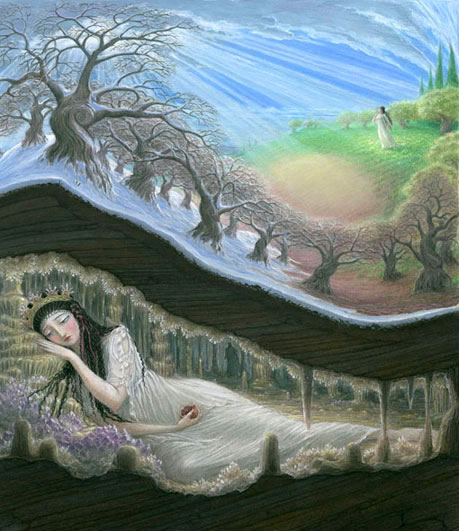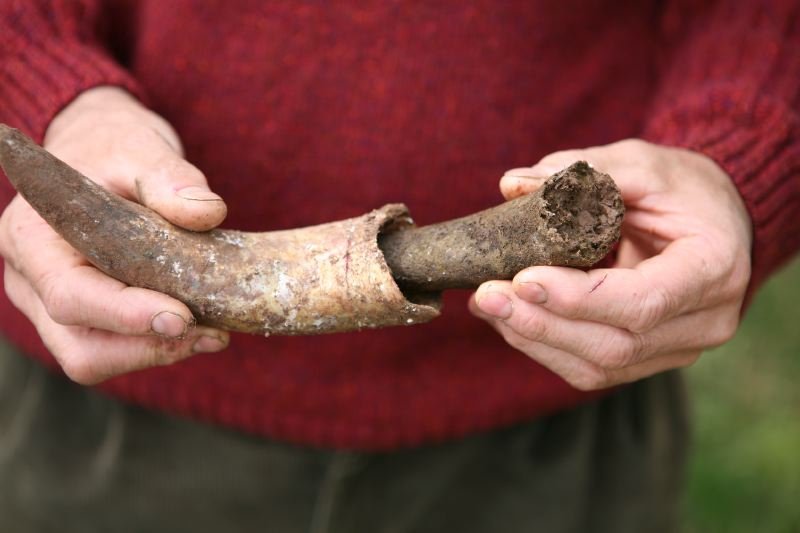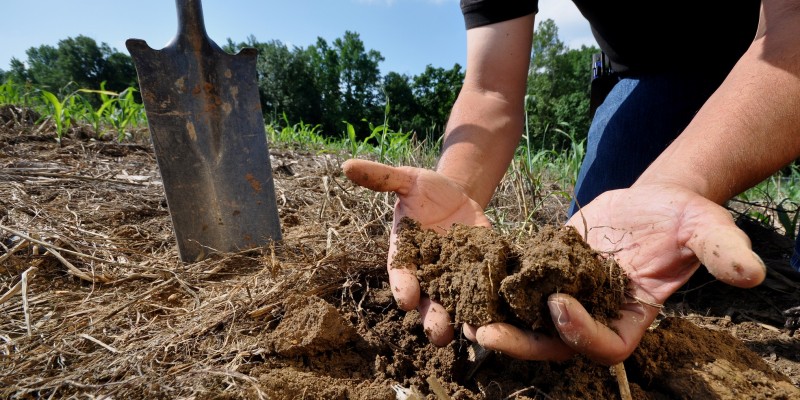| Giving Thanks to the Elementals |
by Hugh Courtney, 2017 Celestial Planting Calendar
In our use of a biodynamic calendar, one of the first things we learn is to pay attention to the nature of the constellations as the Moon travels through the Zodiac each month and year. We understand early on that we will likely have better results if we plant tomatoes in a Fruit period rather than in a Root, Leaf or Flower period. Going a little deeper into the meaning of the constellations, we learn that each of these plant organs also relates to a fundamental characteristic of the various constellations with Fruit equated to the element of Fire; Root to the element of Earth; Flower to the element Air; and Leaf to the element Water in a rhythm that repeats itself three times throughout the solar year. Each of these elements―Fire, Earth, Air, and Water―is viewed according to ancient wisdom as a condition of matter or material substance. Everything in the physical world manifests with one or a combination of these material conditions.
The concept Earth encompasses everything deemed a solid substance. Water encompasses everything of a liquid nature. Air encompasses all that is of a gaseous nature. Fire encompasses everything possessed of warmth. It should be noted that present day material science no longer recognizes the concept Fire as a condition of material substance, allowing only the three conditions of Earth, Water and Air to exist in any scientific calculations.
We are assured by Steiner in his numerous lectures that behind the visible world of matter there can be found an infinite number of spiritual beings who stay busy ensuring that the physical world continues to exist. Steiner, using the terms of traditional wisdom (or folklore), speaks of “very useful” elemental beings referring to Gnomes, Undines, Sylphs and Salamanders.
Each of these groups of beings has responsibility for a particular domain of the conditions of matter with Gnomes concerned about Earth, Undines about Water, Sylphs about Air and Salamanders about Fire. Steiner often uses the term Fire Spirits for the latter beings. He repeatedly indicates that without the work of these various elemental beings the plant world could not exist.
Those of us not gifted with Steiner’s clairvoyance generally bring a hefty skepticism to the concept of elemental beings because we have been conditioned through modern education to disregard anything that cannot be perceived with the senses. Without capability of being weighed, measured and counted, such things as Steiner describes obviously do not exist to the modern well-educated person. Nevertheless, Steiner urges that recognition by humanity of the existence of elemental beings is absolutely vital to further the positive evolution of planet Earth and all that exists thereon, including human beings. Besides Steiner, there are more than a few other people who seem able to perceive elemental beings.
One such individual was Hugo Erbe (1894-1953), who was a serious student of Steiner, a dedicated biodynamic practitioner and ultimately someone who could converse easily with elemental beings, having experienced their presence onward from his early childhood. Erbe became deeply disturbed by the disruption experienced by the elemental kingdoms after the plethora of atomic and hydrogen bomb testing and he worked with great diligence at developing new biodynamic preparations to address this disruption. Altogether, he developed a total of 21 different preparations; each one aimed at solving specific problems in agriculture which he felt could not be fully addressed by the original biodynamic preparations introduced by Steiner.

In particular, two of Erbe’s preparations are intended to foster a cooperative working relationship with the elemental kingdoms. The Three King’s Preparation (HE8), consisting of gold, frankincense and myrrh in a special solution, and made and applied at a particular time of the year, was intended to create a circle of protection within which positive elemental beings find both nourishment and sanctuary, while barring entry to malevolent beings. The Harmonizing Preparation (HE9), consisting of sunflower oil, salt, egg whites, honey, cow’s milk and red grape juice specially blended with wheat grits or whole wheat flour and applied during the season of Michaelmas (September 29), is intended as an expression of gratitude to the elemental beings.
Another person who had a direct awareness of elemental beings was Ehrenfried Pfeiffer (1899-1961), who was largely responsible for bringing biodynamic agriculture to North America. Pfeiffer, in his 1941 presentation “Elemental Beings in the Spiritual World – The Bearers of the Lower Forces in Nature,” noted the following:
“It is a peculiar reality, not just accidental, that the elementary world of North America is more easily accessible than the elementary world of Europe, except for certain regions of Scotland, Norway and the Swiss mountains. ... The elemental beings in Europe are in general older and more experienced. The American elementals as compared with the Eastern ones are relatively ‘young.’ ... As a matter of fact the elemental beings are nourished or starved by thoughts or feelings. The celebration of a ritual has an educational value to them. ... In general the elemental beings which have had the chance to follow the stream of the old mysteries in the center of Asia westward to Europe, finally a being connected with the mystery of Golgotha, are very refined beings filled with energy, harmony, peace, balance and health. Beings which have not had this influence are weaker, easier to disturb and so forth. Especially the lack of reverence among the peoples of any continent of the earth tends to make the elemental brings rather uneducated and naughty. ... It seems to be a great task to improve this spiritual undernourishment of the North American elemental world.”
Pfeiffer recommends several steps to address this challenge:
1. Open the human mind to the spiritual situation in the elemental
world and the struggle these beings have in North America;
2. Educate to increase the desire for beauty and harmony;
3. Educate to develop feelings and thoughts of harmony, balance
and construction; and finally,
4. Develop a spiritual school conducted by those persons
conscious of order where a ritual can be celebrated in which
the elementals participate. Such a center needs to be free of all
desire, including the impulse to become powerful.
How then do we in our biodynamic practice rise to the challenge of working with the elemental beings? What can those of us who are still lacking the clairvoyant abilities of Rudolf Steiner, Hugo Erbe or Ehrenfried Pfeiffer do to answer Steiner’s call to recognize and work with the elemental beings? Of course we can continue our own efforts at spiritual development which can benefit from Steiner’s guidance in that regard. In the meantime, we can simply start a dialogue of recognition and acknowledge that these beings do exist and actually thirst for our awareness.
One additional conscious step we can each take individually is to address the elemental beings directly at any time we stir or apply a biodynamic preparation. In other words, we each in our own way can consciously include the elemental beings when we apply these preparations. A thought that is worth holding is that these preparations constitute very positive nourishment for the elementals and they furnish powerful tools for these beings to use in accomplishing their work with the plant kingdom.
An excellent starting point for creating a ritual to include the elementals, which each of us can implement on our own, is available in the Sequential Spray Technique which employs all nine of Steiner’s preparations in one form or another. This technique addresses the needs of each of the groups of elemental beings within the full spectrum of all the preparations.
If beyond our individual use of this technique we arrange with others in the biodynamic community to participate with us at the same time of the year, say at St. John’s Day (June 24), we would already be fairly far down the path toward establishing a center such as Pfeiffer wished. Such a center does not require a physical, geographic location; it simply can be established in our hearts especially when accompanied by our deeds. In fact, Pfeiffer actually referred to such a center as a “cult of the heart.”
If we also take up the use of both the Three Kings Preparation and especially the Harmonizing Preparation and incorporate them as part of our biodynamic practice each year, we will go a long way towards gaining the cooperation of these elemental beings as Steiner deemed so necessary. One of the most powerful aspects of using the Three Kings Preparation is to realize that dozens if not hundreds of people throughout the world are applying this preparation all at the same time. Such a concerted effort sets up a mighty resonance between each participating site that has to have a profound effect. If we also commit to using the Harmonizing Preparation during the time between Michaelmas and the Thanksgiving holiday (Canadian or American matters not), a further resonant energy will be created that may let the elemental world know that there are at least some humans who are acknowledging their presence and their role.
Beyond the seasonal use of a Sequential Spray Technique, incorporating both the Harmonizing Preparation and the Three Kings Preparation in the yearly approach to our biodynamic efforts can go a long way in establishing a North American Biodynamic Elemental Cult of the Heart.
Sequential Spray Technique - involves a rhythmical application of all nine of the biodynamic preparations (including Barrel Compost, BD500, BD501 and BD508) over a two or three day period with all sprays preferably applied when the Moon is in a Leaf/Water constellation (for lack of moisture) or in a Fruit/Fire constellation (when moisture is excessive).
For availability of HE8 & 9, contact Earth Legacy Agriculture, L.L.C., PO Box 72, Woolwine, VA 24185 USA; via e-mail at grow@earthlegacyagriculture.com; or phone: 276-930-1377
 Hugh Courtney - Writer, Mentor, Researcher Hugh Courtney - Writer, Mentor, Researcher
In addition to contributing articles, Hugh Courtney has taken on the advisory role of forecasting favourable and unfavorable times for this calendar. He has devoted more than 40 years to perfecting the art of making biodynamic preparations. Taking a cue from his own mentor, Josephine Porter, who declared, “These preparations are no secret, I will teach anyone who wants to learn how to make them,” he has mentored hundreds of people on the finer points of making quality preparations.
Ever concerned about keeping this special art form alive into the future, in 2009, along with his grandson, Jeremiah Proctor, Hugh founded Earth Legacy Agriculture, LLC to provide quality preparations for discerning practitioners. www.earthlegacyagriculture.com
|
|
|
| Persephone and Her Relation to the Moon and the Planting Seasons |
 by Stuart Clarkson and Rosemary Tayler, 2017 Celestial Planting Calendar by Stuart Clarkson and Rosemary Tayler, 2017 Celestial Planting Calendar
The mythology of the ancient Greeks reckoned there were only the summer, autumn and winter seasons. Summer held both the planting and harvest seasons and, with respect to the fields, had no greater representation than the goddess Demeter. At first, she probably had been a broadly construed earth goddess figure but later was associated more specifically with the harvest, the gifts of the earth, and with the warm golden glow of summertime. As the Greeks pondered the earth and the vegetative life it nurtured, they recognized that the seeds, biding their time below ground before coming to life above, were like the spirits of the dead, according to their beliefs. This association took mythological form in the marriage of Hades, Lord of the Underworld, to Demeter’s daughter, Persephone, who dwelt below ground with him in winter and returned to her mother above at the start of summer. She therefore encompassed the power of vegetative life to burst forth and then to withdraw into the soil again, and together with her harvest-mother, the two completed the full cycle of the agricultural seasons.
Unlike the Greek system, the Roman calendar was comprised of our traditional four seasons, with the addition of spring. The history of the word “season” reaches back to Latin words relating to the sowing of crops, modified in medieval French to mean the time of sowing, the springtime. The Romans therefore had a more appropriate place to fit the myth of Persephone, or Proserpina as they called her, into their growing calendar, and she became directly related to springtime, being considered by Cicero as the metaphorical seed which led to all fruits of the earth. Despite this, however, the Romans also necessarily had to adjust the duration of Persephone’s residence underground, as four months now straddled two seasons. They resolved this by imposing an equal balance of six months in the worlds above and below the ground.
An important understanding arose from this revision, if in fact it was not an actual reason for the revision upon which the Romans settled. Maurus Servius Honoratus, a late fourth century grammarian, commenting on Virgil’s Georgics poems, connected Proserpina’s six-month absence below the earth with the six months in total during the solar year when the moon is waning. This is an interesting contrast to her mother’s crucial connection with the sun. Where ripening crops relate primarily to light and heat and the solar forces, it seems Servius recognized that seeds relate more to water and to the lunar forces.
He made this connection between seeds and the moon explicit. Servius explained Luna, their personified moon-goddess, and Diana, also a goddess of the moon, along with Proserpina as aspects of a trinity moon-goddess with their three corresponding spheres of influence―in the sky, on the earth and beneath it.
This is supported by Vedic astrology, which originated in India. Chandra, also called Soma, is not only god of the moon but also of plants and vegetation and represents mental and emotional states of softness and the feminine nature. The connection of this god with water is also supported by a Hindi mantra, Mantra Pushpam, one verse of which is “Chandramaa vaa apaam pushpam,” translated as “Chandra (Moon) is the flower of water.”
Interestingly, this interpretation shifts the paradigm for growing/non-growing seasons from the solar sphere of Demeter (waxing/waning of solar power) to the lunar sphere of Persephone (waxing/waning of lunar power).
Medieval Europe carried on the tradition that the moon rules over the seeds, imagining that they grew in the earth due to the dew which fell from the body of the moon, so that the fruits of the earth originated with the moon. These ancient traditions coincide with the beliefs and practices put forward by Maria Thun about the benefits of choosing seasonal “right times” for planting, both by the moon’s phases, as well as by the seasons of the solar year.
|
|
|
| An Introduction to Biodynamic Preparations |
by Hugh Courtney, 2017 Celestial Planting Calendar
Rudolf Steiner in the early part of the last century (1924) offered the concept of the preparations to farmers concerned about some of the already negative results of the use of agricultural chemicals. Biodynamic agriculture does not just offer an alternative to chemical agriculture; it offers a means to renew agriculture at a basic spiritual level. In a statement to Ehrenfried Pfeiffer, Steiner stated that the purpose of the preparations was to “heal the earth.” In an effort to both encourage and challenge growers to proceed with a true biodynamic effort, a summary of Steiner’s preparations and a brief background as to why their use is important is outlined in what follows.
The Spray Preparations: Horn Manure and Horn Silica
Steiner presented two basic preparations now known as horn manure (BD500), and horn silica (BD501). BD500 consists of cow manure packed into a cow horn and buried during the winter months. BD501 involves finely powdered silica (most often from quartz crystals) packed into a cow horn, but buried in the summer months. For use, a small portion of each is separately stirred for one full hour and sprayed on the soil (BD500) and on plants (BD501). The simplistic description of the result for BD500 is that it “enlivens” the soil, whereas BD501 “strengthens” the plant. In a more imaginative view, the horn manure, by awakening “earthly” forces, turns dead soil into living humus, while the horn silica brings down cosmic forces to allow the plant to connect with its spiritual archetype. They are to be used together to harmonize and balance the realm of agriculture and the natural world. A one-sided emphasis on the horn manure, which often is the case in biodynamics, can actually lead to rampant growth.

The classic approach in biodynamic practice is that before these spray preparations are to be used, one should have first applied compost made with the six compost preparations.
Horsetail Preparation
Steiner finished his lecture on preparations by describing one more spray, the horsetail herb, Equisetum arvense, which is referred to as BD508. In some European circles it is not assigned a designation as a preparation. Steiner offered a recipe for horsetail to be used as a kind of liquid manure to counter the strong fungus inducing forces of the Moon. Close observation of its use suggests that horsetail may be very helpful in stimulating or diminishing the watery forces in one’s biodynamic practice.
The Compost Preparations
Steiner gives us a description of the farm as a living organism or a ‘farm individuality,’ which ultimately strives to be self-sustaining. If we picture the role of the preparations in manifesting this organism, and assign each preparation the same ‘nature’ in the compost pile that various organs have in the human body, we may understand better the importance of making compost with these six preparations. When we use the compost preparations, we are co-creating with them a living organism that will help awaken an ‘individuality’ for our farm or garden. It is helpful to view each preparation as a carrier or vehicle of various forces, and not see them as merely material substance. For instance, it is not so much the substance of an element, say silicon, but rather the energetic forces associated with it.
Yarrow blossoms, in bladder of a stag (BD502), relates to lungs and bladder, respiratory system. Enables plants to attract trace elements in extremely dilute quantities for their best nutrition.
Chamomile blossoms, in bovine intestines (BD503), relates to the digestive system. Stabilizes nitrogen within the compost and awakens soil life so as to stimulate plant growth.
Stinging nettles, above ground plant (BD504) surrounded by peat moss when buried, relates to the heart, spleen and circulatory system. Enhances and stimulates soil health, providing plants with individual nutritional components. “Enlivens” the earth (soil).
Oak bark, in skull of a domestic animal (BD505), relates to the brain and nervous system. Provides healing forces or qualities to combat harmful plant diseases.
Dandelion blossoms, enclosed in mesentery or peritoneum tissue (BD506), relates to the liver, gall bladder and hepatic system. Stimulates the relation between silicon and potassium so that the silicon can attract cosmic forces to the soil.
Valerian blossom juice, fermented (BD507), relates to the skin and skeleton. Stimulates compost so that phosphorus components are properly used by the soil.
Using the Compost Preparations
The ingredients of a compost pile can include a wide range of vegetative matter, such as hay, straw, garden residues, grass clippings, kitchen wastes, as well as animal manures, soil and rock dusts. The pile is built in layers of the different materials alternating between dry and green (or carbon and nitrogen) matter. A backyard compost pile needs to be 3’ x 3’ x 3’ as a minimum. Anything smaller will not heat up effectively. Each pile requires its own set of compost preparations. The compost preparations are inserted into the newly built pile as early in the composting process as possible. Although the Valerian preparation is often sprayed over the pile, some practitioners choose to place it into the pile. One does not need to constantly turn a pile once the preparations have been inserted; turning is necessary only to ensure composting of weed seeds. Frequent turning simply oxidizes the material rather than allowing it to go through a breakdown and subsequent buildup of humus.
Compost can be used at the point when it has transformed into a colloidal nature. Ehrenfried Pfeiffer indicated that Root crops (carrots, etc.) should receive well-finished, year-old compost, whereas Fruit crops, especially heavy feeders such as tomatoes, should receive three-month-old compost. Leaf and Flower crops should be given six-month-old compost. A simple experiment making two different piles side by side using the same ingredients, with one pile treated with BD preparations will clearly demonstrate how effective these preparations transform raw materials into good humus.

Barrel Compost (BC) - Also called Cow Pat Pit or Fladen-preparat, barrel compost is a recipe devised by Maria Thun consisting of 50 liters (12.5 gallons) of fresh cow manure, 500 grams of basalt (volcanic rock) powder and 100 grams of ground eggshells, stirred together for one hour, placed in a bottomless barrel buried halfway in the ground with the six compost preparations inserted into this mixture. This is one of several compound preparations designed to be used in spray form to bring the energy of the compost more readily into the soil. It is an excellent tool when sufficient compost is lacking.
Three Kings Preparation (HE8) - A special preparation developed by Hugo Erbe intended to create a sanctuary for elemental beings against the effects of radiation. Consisting of Aurum (gold) D-2 homeopathic dilution, Frankincense and Myrrh in equal portions, ground together with mortar and pestle for one hour, preferably at the midnight hour on New Year’s Eve (the midpoint of the 12 days of Christmas) and then applied on the afternoon of Three Kings Day (January 6), the conclusion of the 12 days. Steiner indicated that New Year’s Eve midnight is a unique and special time when cosmic forces radiate onto Earth.
Harmonizing Preparation (HE9) - Also developed by Hugo Erbe, this preparation consists of sunflower oil, salt, egg whites, honey, cow’s milk and red grape juice specially blended with wheat grits or whole wheat flour and applied during the season of Michaelmas (September 29), is intended as an expression of gratitude to the elemental beings.
For availability of Rudolf Steiner’s and Hugo Erbe’s preparations contact Earth Legacy Agriculture, L.L.C., PO Box 72, Woolwine, VA 24185 USA; phone 276-930-1377 or email
grow@earthlegacyagriculture.com
 Hugh Courtney - Writer, Mentor, Researcher Hugh Courtney - Writer, Mentor, Researcher
In addition to contributing articles, Hugh Courtney has taken on the advisory role of forecasting favourable and unfavorable times for this calendar. He has devoted more than 40 years to perfecting the art of making biodynamic preparations. Taking a cue from his own mentor, Josephine Porter, who declared, “These preparations are no secret, I will teach anyone who wants to learn how to make them,” he has mentored hundreds of people on the finer points of making quality preparations.
Ever concerned about keeping this special art form alive into the future, in 2009, along with his grandson, Jeremiah Proctor, Hugh founded Earth Legacy Agriculture, LLC to provide quality preparations for discerning practitioners. www.earthlegacyagriculture.com
|
|
|
| Weather Wisdom from the Elders |
Weather Wisdom from the Elders: Life with the Cosmos Explained
by Rosemary Tayler, 2017 Celestial Planting Calendar
 Dew on the grass, no rain will come to pass. Dew forms on the surface of the grass as it cools. This occurs under clear skies at night when the heat radiates from the ground. If the sky remains clear, there will often be no rain, but if a weather system moves in during the day, then a change in the weather will follow. Dew on the grass, no rain will come to pass. Dew forms on the surface of the grass as it cools. This occurs under clear skies at night when the heat radiates from the ground. If the sky remains clear, there will often be no rain, but if a weather system moves in during the day, then a change in the weather will follow.
A cow with its tail to the West makes the weather best, a cow with its tail to the East makes the weather least. Cows prefer not to have the wind blowing in their faces, thus they stand with their backs to the wind. Westerly winds usually mean that fair weather will be arriving or continue, and easterly winds usually mean unsettled weather will be arriving or continue. A weathervane or cowvane is thus a good a way of knowing what the weather will be for the next few hours.
Clear Moon, frost soon. When the night sky is clear, Earth’s surface cools rapidly – there is no cloud cover to keep the heat in. If the night is clear enough to see the Moon and the temperature drops enough, frost will form. Expect a chilly morning!
If there is a halo round the Sun or Moon, then we can all expect rain quite soon. This halo is caused by refraction of the light through ice crystals that form from high cirrus clouds. Cirrus clouds are usually the first clouds to appear before a weather front moves in.
Tomatoes seem to know what next winter will grow. If your tomatoes seem to have a lower meat content and many small seeds, they are likely expecting a dryer season whereby they leave extra seeds to improve the odds that some will hold over for the next year and sprout.
When clouds appear like towers, the earth is refreshed by frequent showers. Large, white clouds that look like cauliflowers or castles in the sky, indicate lots of dynamic weather going on inside. If the clouds start to swell and take on a grey tint, they will likely turn into a thunderstorm.
No weather is ill, if the wind be still. Calm conditions, especially with clear skies, indicate the dominance of a high pressure system moving in. Because high pressure systems are broad regions of descending air, they discourage the formation of clouds, wind and precipitation. Calm conditions, however, may also result from a circumstance referred to as “the calm before the storm,” in which a large thunderstorm cell to the west may be updrafting the westerly surface wind before it arrives. This situation is easily identified by looking to the west — such an approaching storm will be certain to occur.
When windows won’t open, and the salt clogs the shaker, the weather will favor the umbrella maker. Moisture in the air causes wood to swell, making doors and windows sticky. Salt is a very effective absorber of moisture. With a high level of moisture in the air, the likelihood of precipitation is increased.
Bees nesting in trees, means lots of snow. When hornets, wasps and bees build their nests higher than normal in trees, expect lots of snow.
|
|
|
|
|


![]()


 Hugh Courtney - Writer, Mentor, Researcher
Hugh Courtney - Writer, Mentor, Researcher  by Stuart Clarkson and Rosemary Tayler, 2017 Celestial Planting Calendar
by Stuart Clarkson and Rosemary Tayler, 2017 Celestial Planting Calendar

 Dew on the grass, no rain will come to pass. Dew forms on the surface of the grass as it cools. This occurs under clear skies at night when the heat radiates from the ground. If the sky remains clear, there will often be no rain, but if a weather system moves in during the day, then a change in the weather will follow.
Dew on the grass, no rain will come to pass. Dew forms on the surface of the grass as it cools. This occurs under clear skies at night when the heat radiates from the ground. If the sky remains clear, there will often be no rain, but if a weather system moves in during the day, then a change in the weather will follow.